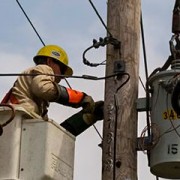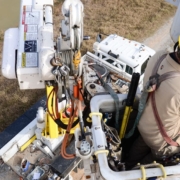Knowing what to do saved their lives
When teenagers Lee Whittaker and Ashley Taylor saw a power line safety demonstration at their high school, they never dreamed what they had learned that day would be put to test. Only days later, Whittaker and Taylor, along with two classmates, were in a car that crashed into a utility pole, bringing live power lines to the ground.
“When people are involved in a car accident, electricity is usually the last thing on their minds,” explains Molly Hall, executive director of the Energy Education Council’s Safe Electricity program. “We’re usually more concerned about whether anyone was injured or how badly the vehicle is damaged. We can forget that by exiting the vehicle, we’re risking exposure to thousands of volts of electricity from downed power lines.”
If you are in an accident with a utility pole, your vehicle may be charged with electricity. If this is the case and you step out of the car, you will become the electricity’s path to the ground and could be electrocuted. Loose wires and other equipment may be in contact with your car or near it—creating a risk for electrocution if you leave the vehicle.
While downed lines can sometimes reveal they are live by arcing and sparking with electricity, this is not always the case. Power lines do not always show signs that they are live, but they are just as lethal.
After an accident, stay in the car, and tell others to do the same. If you come upon an accident involving power lines, do not approach the accident scene. If you see someone approaching, warn them to stay away. Call 911 to notify emergency personnel and utility services. Do not leave your vehicle until a utility professional has told you it is safe to do so.
The safest place to be is almost always inside the car. The only circumstance when you should exit the vehicle is if it is on fire—and those instances are rare. If you must exit the vehicle, jump clear of it with your feet together and without touching the vehicle and ground at the same time. Continue to “bunny hop” with your feet together to safety. Doing this will ensure that you are at only one point of contact and will not have different strengths of electric current running from one foot to another, which can be deadly.
Whittaker, Taylor and their friends survived their accident because they had learned what to do. While they waited more than 30 minutes for line crews to arrive and deactivate the power line, Whittaker and Taylor made sure nobody left the car and warned those who came upon the accident to stay far away.
“Knowledge was crucial in keeping everyone involved in the accident safe,” Hall says. “We want to make sure that everyone knows what to do if they’re in accidents with power poles.”
For more information and to see Lee and Ashley’s story, visit SafeElectricity.org. If you would like to have the TECA Safety Demonstration Trailer at your event, click here.










